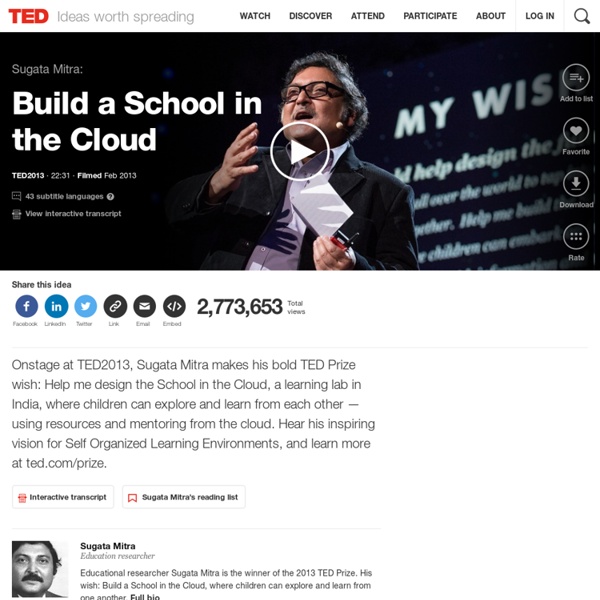Group Work Strategies to Ensure Students Pull Their Weight
The idea for sharing this post came from a session I recently conducted at the annual teaching conference organized by my university. A pedagogical conundrum was raised by a colleague whose enthusiasm and question stayed with me and inspired me to write this post. The question posed by this colleague is relevant to all instructors who have ever used group work to assess their students: How should one deal with the issues that arise when members of a group are not picking up their share of the responsibilities during a group work project? The benefits of group work are well recognized (e.g., as are the reasons students don’t like working in groups (Taylor, 2011).
Re-imagining school
Now playing Salman Khan talks about how and why he created the remarkable Khan Academy, a carefully structured series of educational videos offering complete curricula in math and, now, other subjects. He shows the power of interactive exercises, and calls for teachers to consider flipping the traditional classroom script — give students video lectures to watch at home, and do "homework" in the classroom with the teacher available to help.
Mr. C's SharesEase
This great video clearly outlines Genius Hour movement happening in classrooms across the world! After reflecting for a few months on how to initiate #GeniusHour in my classroom I finally jumped in with both feet, my Genius Journal (click to download) and the question, “What do YOU want to learn Today”? The response, learning, level of engagement and finished products were incredible! I found my Genius Journal to be incredibly helpful in guiding my students, allowing them to follow a process (QUESTION-PLAN-RESEARCH-CREATE-SHARE-REFLECT) and record their learning. Of course, the process is fluid during their 20% in the classroom. The most critical component of Genius Hour is insuring that your students formulate good, thought provoking questions.
6 Important Components Of Online Pedagogy
Originally posted on What makes you a good instructor in the classroom – does not necessarily translate to good pedagogy in an online learning environment. Online Learning Environments are becoming increasingly available for learners in all areas of education from primary grades right through to higher education. They require key considerations to be cultivated to promote success.
SAMR Model Explained for Teachers
Below is a great video explaining the SAMR model in 120 seconds. SAMR is a framework through which you can assess and evaluate the technology you use in your class. Here is how the video below shared by Candace M explains the SAMR's four levels: Substitution In a substitution level, teachers or students are only using new technology tools to replace old ones, for instance, using Google Docs to replace Microsoft Word. the task ( writing) is the same but the tools are different.
Clearing the Confusion between Technology Rich and Innovative Poor: Six Questions
** We are seeking global opinions, please consider commenting with your thoughts and ideas of the definition of innovation** In a recent webinar, more than 90% of school leaders responded that they were leading an innovative school as a result of the implementation of technology. At the end of the webinar, when polled again, only one leader claimed to be leading an innovative school. The complete reversal was due to a presentation of the Six Questions that you will read about in this article.
3 Ways Coding and Gaming Can Enhance Learning
Coding isn't just for computer science any more. Educators are finding that teaching students to write code and design games enhances learning and creates engagement. These examples illustrate how coding and games are being used across the curriculum and at all levels, as well as why great teaching is at the very heart of this innovation.
Time to Start Making: Free Design Programs for 3D Printers
By James Floyd Kelly One of the biggest tech trends to follow is the evolution of 3D printing — not just in the consumer market, but also in education. In fact, last month, the NMC Horizon report predicted that 3D printers will be seen in schools in the next five years, as students and teachers experiment with creating real objects out of plastic and other materials.
Tips and Tools for Involving Students in Lesson Planning and Content Delivery
Planning for a trip can be just as exciting as the vacation itself, especially when the planning is shared between family or friends. The preparation process and this kind of shared communication about your upcoming adventure starts to build excitement, even before you arrive at your destination. Later, you might reflect back on the journey by sharing this with other friends and family members--or sometimes, the adventure can be shared in real-time, depending on the tools that you are using. What if teachers and students could discover academic goals in the same way that one would plan for a travel adventure--together? When teachers involve students in tech-enhanced lesson planning and content delivery, then true ownership of the learning can be the positive result. Step A: Knowing the Learning Objective
A New Dimension of Education Technology
I bumped into SCiO and was inspired that it can actually change the way we design courses. SCiO is a mobile sensor that analyzes fine optical signals of an object, sends them back to the cloud database to do pattern matching, and returns the results to users. Users can easily find out the calories of drinks, sweetness of melons (before buying them), and many other types of information. These are some immediate application that I can see in education. Some fields that I can think of are chemistry, environmental science, entomology, material science, architecture, archeology, food science, plant science, medicine, etc.


